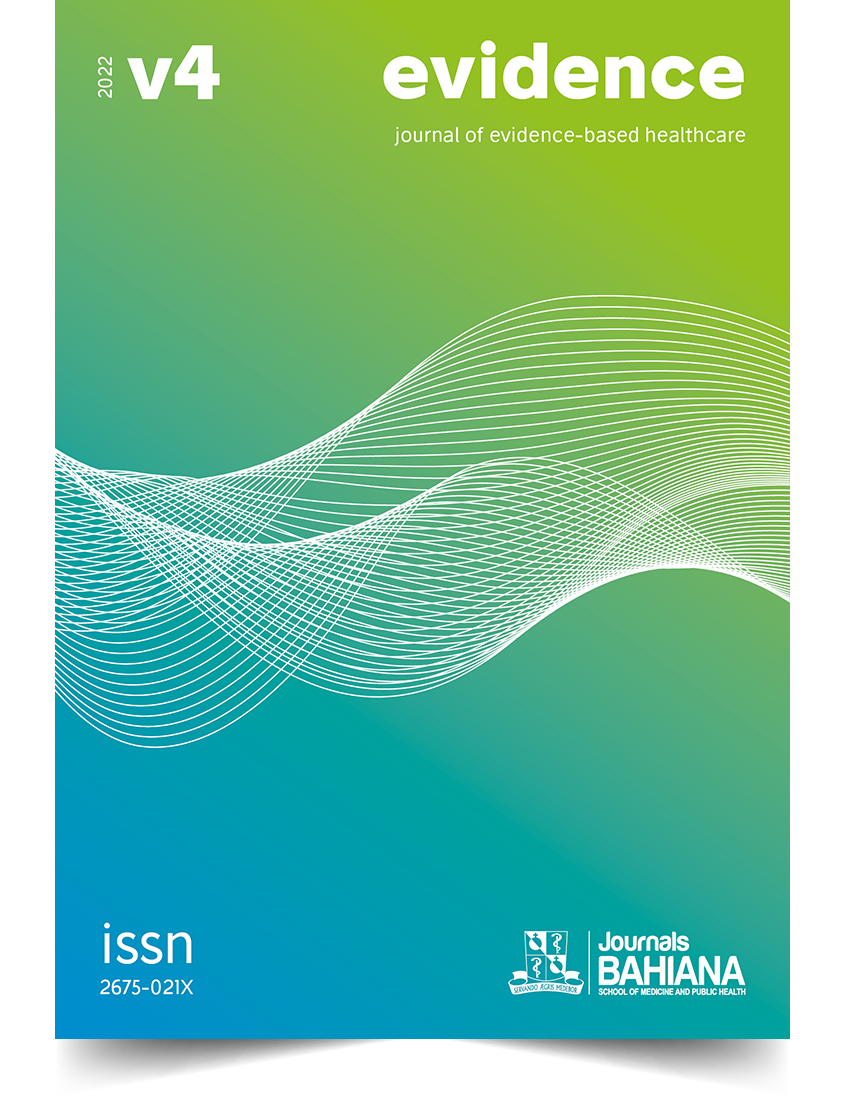Overuse: medical novelty or age-old phenomenon?
DOI:
https://doi.org/10.17267/2675-021Xevidence.2022.e3792Keywords:
History, Medicine, Overuse, PhysicianAbstract
INTRODUCTION: Mentions of overuse tend to imply it is a recent phenomenon as if irrationality was brought about by technological advances and the development of new procedures. However, it is possible that physicians have been prone to the same cognitive biases since antiquity, also performing inappropriate and excessive procedures. This raises the question of whether the contemporary issue of overuse is a modern phenomenon or inherited from a multi-millennial medical tradition. OBJECTIVE: To infer an answer to this question by summarizing the medical literature about overuse throughout the history of medicine. METHODS: Medical overuse is defined as futile, low-value procedures characterized by excessive use of methods with a high probability of causing more harm than good to patients. It examines the history of medical literature, with a critical look at procedures that might be characterized as harmful, futile, or with excessive use of diagnostic and therapeutic methods. RESULTS: This analysis revealed evidence that such procedures have been taking place throughout many periods of history. Studies have shown that the current prevalence of inappropriate medical procedures can be as high as 29% in the United States and 80% of cases for some individual services around the world. Lack of reliable data thwarts accurate analysis of the prevalence of overuse before the last decade. CONCLUSIONS: Instead of a recent phenomenon, overuse has permeated medical practice from its beginnings until today, regardless of technological advances, and is possibly inherent to the human species.
Downloads
References
Chassin MR, Galvin RW. The urgent need to improve health care quality. Institute of Medicine National Roundtable on Health Care Quality. JAMA. 1998;280(11):1000-5. https://doi.org/10.1001/jama.280.11.1000
Mikic Z. Imhotep--builder, physician, god. Med Pregl. 2008;61(9-10):533-8. Cited: PMID: 19203075.
Ali FR, Finlayson AE. Pharaonic trichology: the Ebers Papyrus. JAMA Dermatol. 2013;149(8):920. https://doi.org/10.1001/jamadermatol.2013.4240
Vargas A, Lopez M, Lillo C, Vargas MJ. The Edwin Smith papyrus in the history of medicine. Rev Med Chil. 2012;140(10):1357-62. https://doi.org/10.4067/s0034-98872012001000020
Silva GAR. The decision making process in clinical practide: medicine as a state of the art practice. Rev. Soc. Bras. Clín. Méd [Internet]. 2013;11(1):75-9. Available from: http://bases.bireme.br/cgi-bin/wxislind.exe/iah/online/?IsisScript=iah/iah.xis&base=LILACS&lang=p&nextAction=lnk&exprSearch=668517&indexSearch=ID
Yapijakis C. Hippocrates of Kos, the father of clinical medicine, and Asclepiades of Bithynia, the father of molecular medicine. Review. In Vivo. 2009;23(4):507-14. Cited: PMID: 19567383.
Cordeiro M. Príncipes da Medicina. Saída de Emergência;1995.
Havik PJ. Hybridising Medicine: Illness, Healing and the Dynamics of Reciprocal Exchange on the Upper Guinea Coast (West Africa). Med Hist. 2016;60(2):181-205. https://doi.org/10.1017/mdh.2016.3
Watson G. Theriac and Mithridaticum - A Study in Therapeutics. London: The Wellcome Hsistorical Medical Library; 1966.
Ialongo C, Bernardini S. Phlebotomy, a bridge between laboratory and patient. Biochem Med (Zagreb). 2016;26(1):17-33. https://dx.doi.org/10.11613%2FBM.2016.002
Davis G. The Evolution of Cataract Surgery. Mo Med. 2016;113(1):58-62. PMID: 27039493.
Tefekli A, Cezayirli F. The history of urinary stones: in parallel with civilization. ScientificWorldJournal. 2013;2013:423964. https://doi.org/10.1155/2013/423964
Hajar RMD. The air of history (part v) ibn sina (avicenna): the great physician and philosopher. Heart Views. 2013;14(4):196-201. https://dx.doi.org/10.4103%2F1995-705X.126893
Benini A, Bonar SK. Andreas Vesalius 1514-1564. Spine (Phila Pa 1976). 1996;21(11):1388-93. https://doi.org/10.1097/00007632-199606010-00024
McMullen ET. Anatomy of a physiological discovery: William Harvey and the circulation of the blood. J R Soc Med. 1995;88(9):491-8. Cited: PMID: 7562843.
Donovan AJ. Richard Lower, M.D., physician and surgeon (1631-1691). World J Surg. 2004;28(9):938-45. https://doi.org/10.1007/s00268-004-7553-7
Bhatt A. Evolution of clinical research: a history before and beyond James Lind. Perspect Clin Res 2010;1(1):6–10. Cited: PMID: 21829774.
Wilkins MR, Kendall MJ, Wade OL. William Withering and digitalis, 1785 to 1985. Br Med J (Clin Res Ed). 1985;290(6461):7-8. https://dx.doi.org/10.1136%2Fbmj.290.6461.7
Huang X, Rosenthal MB. Overuse of Cardiovascular Services: Evidence, Causes, and Opportunities for Reform. Circulation. 2015;132(3):205-14. https://doi.org/10.1161/circulationaha.114.012668
Douglas PS, Garcia MJ, Haines DE, Lai WW, Manning WJ, Patel AR, et al. ACCF/ASE/AHA/ASNC/HFSA/HRS/SCAI/SCCM/ SCCT/SCMR 2011 appropriate use criteria for echocardiography: a report of the American College of Cardiology Foundation Appropriate Use Criteria Task Force, American Society of Echocardiography, American Heart Association, American Society of Nuclear Cardiology, Heart Failure Society of America, Heart Rhythm Society, Society for Cardiovascular Angiography and Interventions, Society of Critical Care Medicine, Society of Cardiovascular Computed Tomography, Society for Cardiovascular Magnetic Resonance American College of Chest Physicians. J Am Coll Cardiol 2011;57(3):1126–66. https://doi.org/10.1016/j.echo.2010.12.008
Born KB, Levinson W. Choosing Wisely campaigns globally: A shared approach to tackling the problem of overuse in healthcare. J Gen Fam Med. 2019;20(1):9-12. https://dx.doi.org/10.1002%2Fjgf2.225
Brownlee S, Chalkidou K, Doust J, Elshaug AG, Glasziou P, Heath I, et al. Evidence for overuse of medical services around the world. Lancet. 2017;390(10090):156-68. https://doi.org/10.1016/S0140-6736(16)32585-5
Bhatia RS, Ivers NM, Yin XC, Myers D, Nesbitt GC, Edwards J, et al. Improving the Appropriate Use of Transthoracic Echocardiography: The Echo WISELY Trial. J Am Coll Cardiol. 2017;70(9):1135-44. https://doi.org/10.1016/j.jacc.2017.06.065
Lamy JB, Sekar B, Guezennec G, Bouaud J, Seroussi B. Explainable artificial intelligence for breast cancer: A visual case-based reasoning approach. Artif Intell Med. 2019;94:42-53. https://doi.org/10.1016/j.artmed.2019.01.001
Panch T, Szolovits P, Atun R. Artificial intelligence, machine learning and health systems. J Glob Health. 2018;8(2):020303. https://dx.doi.org/10.7189%2Fjogh.08.020303
Downloads
Published
Issue
Section
License
Copyright (c) 2022 João Ricardo Pinto Lopes, João Souza Filho, Carlos Danilo Crusoé Gomes, Luis Cláudio Lemos Correia

This work is licensed under a Creative Commons Attribution 4.0 International License.
The authors retain copyrights, transferring to the Journal of Evidence-Based Healthcare only the right of first publication. This work is licensed under a Creative Commons Attribution 4.0 International License.



